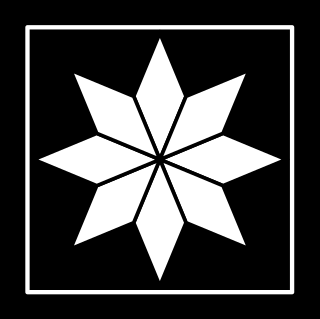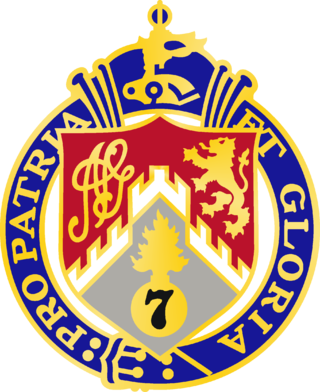
The 24th Division was an infantry division of the British Army, raised in September 1914 from men volunteering for Lord Kitchener's New Armies during the First World War. After almost a year spent training in England the division was sent to the Western Front between August and September 1915. It served in Belgium and France in the trenches of the Western Front for the duration of the war.

The 8th Infantry Division was an infantry division of the British Army that was active in both the First and Second World Wars. The division was first formed in October 1914 during the First World War, initially consisting mainly of soldiers of the Regular Army and served on the Western Front throughout the war, sustaining many casualties, before disbandment in 1919. The division was reactivated in Palestine, under the command of Major-General Bernard Montgomery, in the late 1930s in the years running up to the Second World War before being disbanded in late February 1940. It was briefly reformed in Syria in an administrative role during 1942-3.

The Post Office Rifles was a unit of the British Army formed in 1868 from volunteers as part of the Volunteer Force, which later became the Territorial Force. The unit evolved several times until 1935, after which the name was lost during one of many reorganisations.

The 47th Division was an infantry division of the British Army, raised in 1908 as part of the Territorial Force.

The Royal Irish Rifles was an infantry rifle regiment of the British Army, first created in 1881 by the amalgamation of the 83rd Regiment of Foot and the 86th Regiment of Foot. The regiment saw service in the Second Boer War, the First World War, the Second World War, and the Korean War.

The Cameronians (Scottish Rifles) was a rifle regiment of the British Army, the only regiment of rifles amongst the Scottish regiments of infantry. It was formed in 1881 under the Childers Reforms by the amalgamation of the 26th Cameronian Regiment and the 90th Perthshire Light Infantry. In 1968, when reductions were required, the regiment chose to be disbanded rather than amalgamated with another regiment, one of only two infantry regiments in the British Army to do so, with the other being the York and Lancaster Regiment. It can trace its roots to that of the Cameronians, later the 26th of Foot, who were raised in 1689. The 1881 amalgamation coincided with the Cameronian's selection to become the new Scottish Rifles.
Major General David Murrey Murray-Lyon, was an officer in the British Indian Army. His final appointment was as the General Officer Commanding (GOC) of the 11th Indian Infantry Division in Malaya until he was relieved of his duty by Lieutenant General Arthur Percival. He was taken prisoner when Singapore fell to the Japanese, and spent the rest of the war in captivity.
The 131st Infantry Brigade, originally the Surrey Brigade was an infantry formation of Britain's Territorial Army that saw service during both the First and the Second World Wars. In the First World War the brigade was in British India for most of the war and did not see service as a complete unit but many of its battalions would see service in the Middle East.
The 25th Infantry Brigade was a war-formed infantry brigade of the British Army that saw active service during both the First and the Second World Wars.

The London Irish Rifles (LIR) was a reserve infantry regiment and then company of the British Army. The unit's final incarnation was as D Company, the London Regiment. On 1 April 2022 soldiers in the company transferred to foot guards regiments and the company became No 15 (Loos) Company, Irish Guards.

The East Surrey Regiment was a line infantry regiment of the British Army in existence from 1881 until 1959. The regiment was formed in 1881 under the Childers Reforms by the amalgamation of the 31st (Huntingdonshire) Regiment of Foot, the 70th (Surrey) Regiment of Foot, the 1st Royal Surrey Militia and the 3rd Royal Surrey Militia.

The 87th Battalion, CEF was a Household Foot Guards infantry unit in the Canadian Expeditionary Force during the First World War.

Eric Henri Kennington was an English sculptor, artist and illustrator, and an official war artist in both of the world wars.

The 107th Infantry Regiment was a regiment of the New York Army National Guard. The regiment was formed in 1917 and disestablished in 1993.
The 142nd Brigade was an infantry brigade of the Territorial Army, part of the British Army, that served in the First and the Second World Wars, and remained in the United Kingdom throughout the latter.

The 1st Surrey Rifles was a volunteer unit of the British Army from 1859 until 1993. It saw considerable service on the Western Front, at Salonika and in Palestine during World War I. It served as a searchlight unit and as a light anti-aircraft regiment during World War II.

The Civil Service Rifles War Memorial is a First World War memorial located on the riverside terrace at Somerset House in central London, England. Designed by Sir Edwin Lutyens and unveiled in 1924, the memorial commemorates the 1,240 members of the Prince of Wales' Own Civil Service Rifles regiment who were killed in the First World War. They were Territorial Force reservists, drawn largely from the British Civil Service, which at that time had many staff based at Somerset House.
The 22nd Battalion, London Regiment was an auxiliary unit of the British Army. Formed in 1908 from Volunteer units in the Surrey suburbs of London that dated back to 1860, it was part of the London Regiment in the Territorial Force (TF). Its battalions served on the Western Front and in Palestine during World War I. When the London Regiment was abolished in 1937 the unit reverted to the Queen's Royal Regiment and during World War II its battalions fought in North Africa, Tunisia, Italy and North West Europe. It was amalgamated with other battalions into the Queen's Regiment in 1961.
The 24th Battalion, London Regiment was an auxiliary unit of the British Army. Formed in 1908 from Volunteer units in the Surrey suburbs of London that dated back to 1860, it was part of the London Regiment in the Territorial Force (TF). Its battalions served on the Western Front at Salonika and in Palestine during World War I. When the London Regiment was abolished the unit reverted to the Queen's Royal Regiment and served in the Battle of France, in North Africa, including the Battle of Alamein, and in taly and North West Europe as part of the 7th Armoured Division. Postwar it was converted to an anti-aircraft regiment of the Royal Artillery.

The 23rd Battalion, London Regiment was an auxiliary unit of the British Army. Formed in 1908 from Volunteer units in the Surrey suburbs of London that dated back to 1859, it was part of the London Regiment in the Territorial Force (TF). Its battalions served on the Western Front, at Salonika and in Palestine during World War I. When the London Regiment was abolished the unit reverted to the East Surrey Regiment but just before World War II it was converted to armour as two battalion of the Royal Tank Regiment. In this role it fought in North Africa, including the Battle of Alamein, and in Italy and North West Europe. Postwar it reverted to infantry in 1956 and later was amalgamated with other Surrey battalions into the Queen's Regiment. Its successors continue in today's London Guards.



















